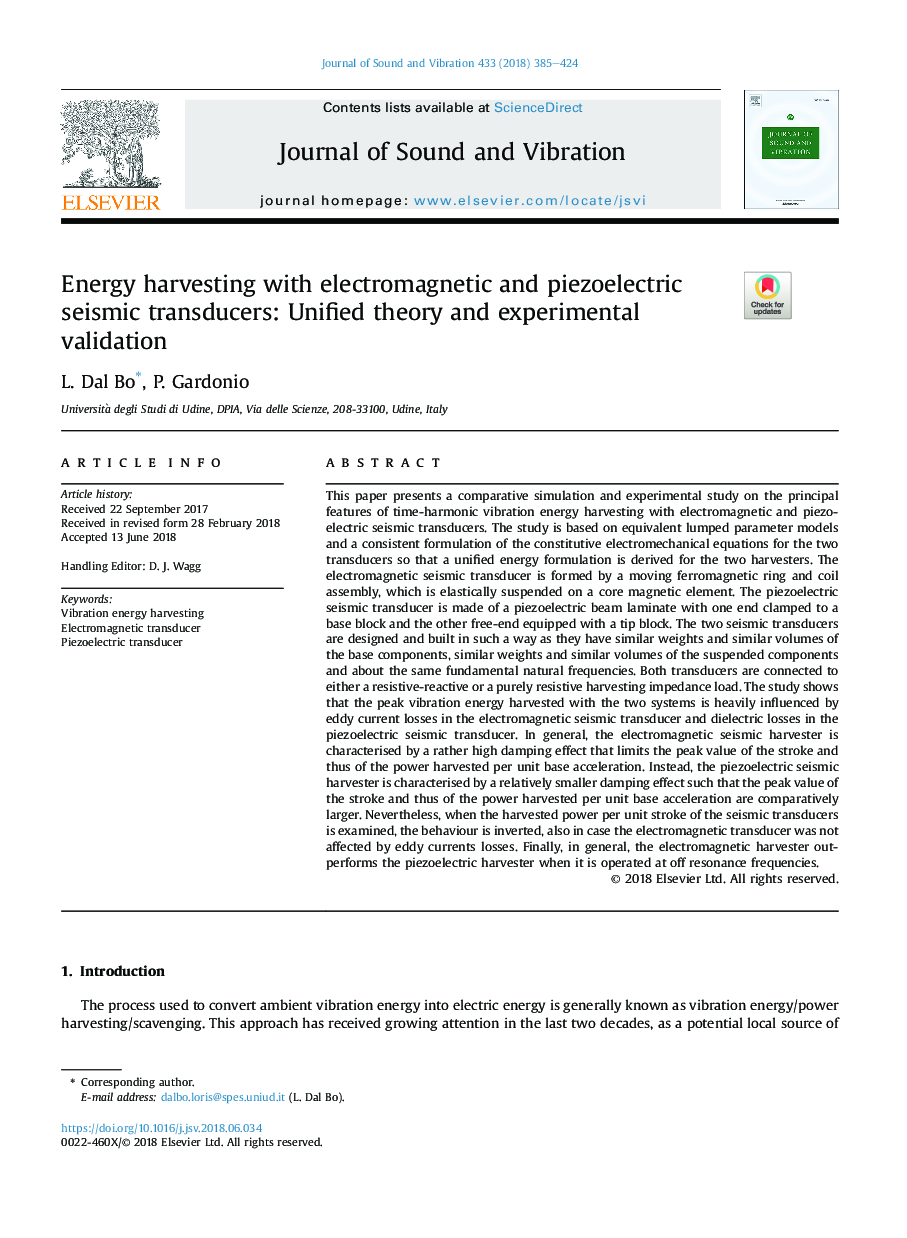| کد مقاله | کد نشریه | سال انتشار | مقاله انگلیسی | نسخه تمام متن |
|---|---|---|---|---|
| 6752582 | 1430800 | 2018 | 40 صفحه PDF | دانلود رایگان |
عنوان انگلیسی مقاله ISI
Energy harvesting with electromagnetic and piezoelectric seismic transducers: Unified theory and experimental validation
ترجمه فارسی عنوان
برداشت انرژی با مبدلهای لرزه ای الکترومغناطیسی و پیزوالکتریک: تئوری یکپارچه و اعتبار سنجی آزمایشی
دانلود مقاله + سفارش ترجمه
دانلود مقاله ISI انگلیسی
رایگان برای ایرانیان
کلمات کلیدی
جمع آوری انرژی لرزش، مبدل الکترومغناطیسی، مبدل پیزوالکتریک،
ترجمه چکیده
در این مقاله شبیه سازی مقایسه ای و بررسی تجربی بر روی ویژگی های اصلی برداشت انرژی انرژی لرزش هماهنگ با مبدل های لرزه ای الکترومغناطیسی و پیزوالکتریک ارائه شده است. این مطالعه بر پایه مدل های پارامترهای معادل توزیع شده و فرمول سازمانی معادلات الکترومکانیکی سازنده برای دو مبدل است، به طوری که یک فرمول انرژی واحد برای دو برداشت محصول به دست می آید. مبدل لرزه ای الکترومغناطیسی توسط یک حلقه فرومغناطیسی در حال حرکت و مونتاژ کویل تشکیل شده است که بر روی یک عنصر مغناطیسی مغناطیسی آویزان می شود. مبدل لرزه نگاری پیزوالکتریک از یک ورقه ورقه پرتو پیزوالکترون ساخته شده است که یک انتها آن را به یک بلوک پایه متصل می شود و دیگری انتهای آزاد مجهز به یک بلوک نوک است. دو مبدل لرزه ای طراحی شده و ساخته شده است به طوری که آنها وزن مشابه و حجم مشابه از قطعات پایه، وزن مشابه و حجم مشابه از اجزای معلق و در مورد همان فرکانس های طبیعی طبیعی است. هر دو مبدل به یک مقاومت امضایی واکنشگر یا یک مقاومت کامل مقاومت در برابر امپدانس وصل می شوند. مطالعه نشان می دهد که انرژی لرزش حداکثر برداشت شده با این دو سیستم به شدت تحت تأثیر ضایعات جریان گردابی در مبدل های لرزه ای الکترومغناطیسی و تلفات دی الکتریک در مبدل لرزه نگاری پیزوالکتریک قرار دارد. به طور کلی، برداشتن لرزه ای الکترومغناطیسی با یک اثر محرک نسبتا بالا که محدودیت مقدار حداکثر سکته مغزی و در نتیجه قدرت برداشت در شتاب واحد را تعیین می کند، مشخص می شود. در عوض، برداشتن لرزه نگاری پیزوالکتریک با یک اثر آرام سازی نسبتا کوچکتر مشخص می شود به طوری که مقدار حداکثر سکته مغزی و در نتیجه قدرت برداشت در شتاب واحد واحد نسبتا بزرگتر است. با این وجود، وقتی که قدرت برداشت شده در هر واحد از مبدل های لرزه ای مورد بررسی قرار می گیرد، رفتار چرخشی معکوس می شود، همچنین در صورتی که مبدل الکترومغناطیسی توسط تلفات جریان های گردابی تأثیر نداشته باشد. در نهایت، به طور کلی، اره الکترومغناطیسی در هنگام استفاده از فرکانس های رزونانس، از برداشت پیزوالکتریک بهتر عمل می کند.
موضوعات مرتبط
مهندسی و علوم پایه
سایر رشته های مهندسی
مهندسی عمران و سازه
چکیده انگلیسی
This paper presents a comparative simulation and experimental study on the principal features of time-harmonic vibration energy harvesting with electromagnetic and piezoelectric seismic transducers. The study is based on equivalent lumped parameter models and a consistent formulation of the constitutive electromechanical equations for the two transducers so that a unified energy formulation is derived for the two harvesters. The electromagnetic seismic transducer is formed by a moving ferromagnetic ring and coil assembly, which is elastically suspended on a core magnetic element. The piezoelectric seismic transducer is made of a piezoelectric beam laminate with one end clamped to a base block and the other free-end equipped with a tip block. The two seismic transducers are designed and built in such a way as they have similar weights and similar volumes of the base components, similar weights and similar volumes of the suspended components and about the same fundamental natural frequencies. Both transducers are connected to either a resistive-reactive or a purely resistive harvesting impedance load. The study shows that the peak vibration energy harvested with the two systems is heavily influenced by eddy current losses in the electromagnetic seismic transducer and dielectric losses in the piezoelectric seismic transducer. In general, the electromagnetic seismic harvester is characterised by a rather high damping effect that limits the peak value of the stroke and thus of the power harvested per unit base acceleration. Instead, the piezoelectric seismic harvester is characterised by a relatively smaller damping effect such that the peak value of the stroke and thus of the power harvested per unit base acceleration are comparatively larger. Nevertheless, when the harvested power per unit stroke of the seismic transducers is examined, the behaviour is inverted, also in case the electromagnetic transducer was not affected by eddy currents losses. Finally, in general, the electromagnetic harvester outperforms the piezoelectric harvester when it is operated at off resonance frequencies.
ناشر
Database: Elsevier - ScienceDirect (ساینس دایرکت)
Journal: Journal of Sound and Vibration - Volume 433, 27 October 2018, Pages 385-424
Journal: Journal of Sound and Vibration - Volume 433, 27 October 2018, Pages 385-424
نویسندگان
L. Dal Bo, P. Gardonio,
